Omakau School in Otago tells us about their journey towards Bronze.
Throughout the past 18 months we have worked hard on researching, developing and creating systems around Omakau School to deal with our waste, beautifying the environment and looking after our mental health with the impact of covid. This has all contributed to being a Bronze Enviroschool!
After some enviro workshops and a visit to Wastebusters we started to make a plan for composting and disposing of food scraps. We also wanted to upcycle items and create a sensory wall (now completed) and an outdoor play kitchen.
“I learnt that you can give items a second chance and change them into something else. I loved looking at all the items they had for sale that people had dropped off.” – Charlotte after the Wastebusters trip.
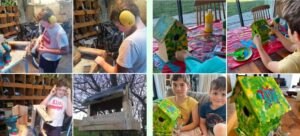
Lockdown home learning sparked some great construction of bird feeders and shelters.
Some of the online learning that resulted from Covid led to creation of bird feeders.
“I really enjoyed working on this project during lockdown. I got to work all day with my dad in his shed building my bird feeder. I reckon it looks pretty great hanging in the tree. I liked watching the birds eating dinner in it.” – Jay Jay
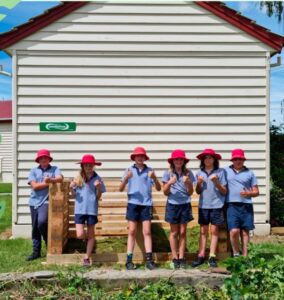
Feeling proud of the compost bins.
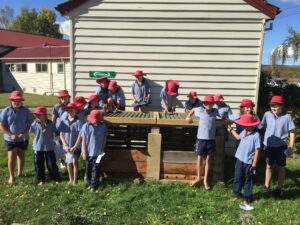
Students explain how the compost bins were constructed and what they are used for.
Using the Enviroschools Zero Waste activity of mapping school waste, students were able to then explore ways to address issues. We sourced some free pallets from PGG Wrightson in Alexandra and used five of them to make a main structure of two compost bays. Timber and recycled corrugated iron was used to construct the lid and then we used milled timber for slats at the front.
“We had to follow a kit set plan to build the compost bin. It was challenging and we all felt proud of the job we had done”. – Zac
We trialed a worm farm and bokashi bucket system for food scraps. We love how bokashi can break down all the scraps. When it is full we brew it for a month and then add it to the compost.
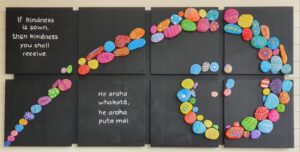
River stones were painted and put together to create a vibrant mural with a message of kindness.
A collaborative project was undertaken creating a mural with locally gathered river stones. These were painted and put together with a whakataukī .
“I really enjoyed painting the stones and I love reading the kindness quote.” – Sophie
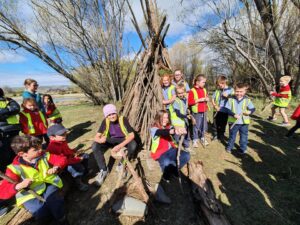
Making river huts was a great way to work together and have fun!
The Manuherekia (Manuherikia) River provided lots of local curriculum learning opportunities on a trip there. Students used a bathyscope, collected macroinvertebrates for identification, checked water clarity, velocity, pH and temperature to gain an understanding of the health of the river. Back at school, the information was graphed and explained.
A great way to ease back into school after lockdown was to walk to the river for lunch and build huts in whānau groups.
“It was so much fun because you got to build your own mini house! My favourite part was planning it at the start and seeing how it ends up. I loved it when we all walked around and checked each others huts out.” – Tainui
The Gillespie family are local farmers on a mission to fence and plant the waterways. Omakau students got to hear their story and be involved in a planting day (see banner image).
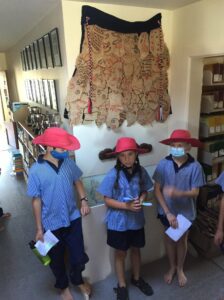
Students explain the process of making the korowai.
To help celebrate Matariki students worked together sewing hessian “feathers” to create a cloak.
“I really enjoyed working with my buddy to design and sew our feathers for the cloak. I found it quite difficult but really loved how it turned out. The feathers all look really good together on our finished korowai.” – Meg
In order to beautify our basketball court we designed a sports themed mural. This was entered into the Resene Mural Competition and received Highly Commended!
We all helped out with our annual Omakau Clean Up as part of “Clean Up NZ”. It was pleasing to note that we only found a small amount of rubbish.
We had the idea of making a small community library – another collaborative project was undertaken, resulting in a sturdily built, brightly painted “Lilliput Library” now mounted on the front fence facing the rail trail.
The food gardens are the focus for 2022. They have been weeded and cardboard has been used to mulch them and suppress further weed growth.
There are many other projects and explorations in the pipeline at Omakau including looking at how we can make even greater changes to lunchbox waste. We will need to apply for funding for rabbit proofing our gardens. There are a whole range of ideas that we can work together on over the next few years – maybe beehives, a greenhouse, native plant nursery and a chicken coop!
We are very lucky to have the support of Enviroschools to guide us through this process. There are some very generous and passionate people in our community too, who support this learning and action.